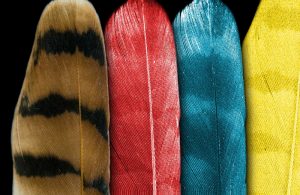
Credit: SLAC National Accelerator Laboratory
In order to discover the true colors of ancient animals, scientists are using X-rays to closely examine the chemical details of modern bird feathers.
The researchers were able to map elements that make up pigments responsible for red and black colors in feathers. They hope to use this information to find traces of the same pigments in fossil specimens of extinct animals, such as dinosaurs.
This latest discovery means that scientists may be able to go beyond monochrome in their depictions of fossilized creatures, and make steps towards portraying their colors more accurately.
The team published their results in the journal Scientific Reports.
The experiments were conducted at the Stanford Synchrotron Radiation Lightsource (SSRL) at the Department of Energy’s SLAC National Accelerator Laboratory and the Diamond Light Source in the United Kingdom. SSRL is a DOE Office of Science user facility.
The international team of scientists, led by the University of Manchester, analyzed the elements associated with a pigment called melanin in feathers shed by birds housed in animal sanctuaries. Melanin is responsible for skin color variation in humans, and it is the dominant pigment in most mammals and birds. The pigment gives animals either a black/dark brown or reddish/yellow color. The black type is called eumelanin, while the reddish type is called pheomelanin.
“Melanin is a very important component in biology, but its exact chemistry is still not precisely known, especially as to how metals such as calcium, copper and zinc interact with it,” says Nick Edwards, a postdoctoral research associate at the University of Manchester and the lead author of the study.
Edwards says the researchers found subtle but measurable differences between the different types of melanin with regards to certain elements.
For example, the X-rays allowed them to see contrasts in the different chemical environments of sulfur and zinc. Zinc, when bound to sulphur in a specific way, could be used as a reliable indicator of the red type of melanin within the feathers of brightly colored birds of prey. And zinc in the absence of sulphur could indicate the black form of melanin.
The team also saw patterns in calcium and copper that match the markings of the tested feathers.
“With X-rays, one of the advantages is that we’re able to map these visual patterns in the chemical elements associated with colors in a non-destructive way,” says Dimosthenis Sokaras, staff scientist at SLAC and a co-author on the paper. “We can study something in its original state.”
An earlier study from the same group revealed light and dark patterns in a fossilized Confuciusornis sanctus, an ancient bird with the first true beak that lived at the same time as the dinosaurs.
“A fundamental truth in geology is that the present is the key to the past,” says Roy Wogelius, professor of geochemistry at the University of Manchester and senior author of the study. “This work on modern animals now provides another chemical ‘key’ for helping us to accurately reconstruct the appearance of long extinct animals.”
Reference:
Nicholas P. Edwards, Arjen van Veelen, Jennifer Anné, Phillip L. Manning, Uwe Bergmann, William I. Sellers, Victoria M. Egerton, Dimosthenis Sokaras, Roberto Alonso-Mori, Kazumasa Wakamatsu, Shosuke Ito, Roy A. Wogelius. Elemental characterisation of melanin in feathers via synchrotron X-ray imaging and absorption spectroscopy. Scientific Reports, 2016; 6: 34002 DOI: 10.1038/srep34002
Note: The above post is reprinted from materials provided by SLAC National Accelerator Laboratory.










